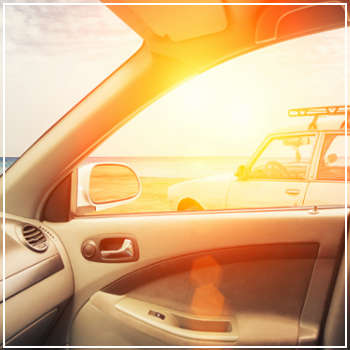How UV Exposure Can Harm Your Car
When your car sits in the sun, internal temperatures can skyrocket to between 145 and 195 degrees Fahrenheit. Over time, you'll begin to notice visible signs like cracks and discoloration on the dashboard, upholstery, paint, and even some hidden parts of your vehicle. Since the dashboard is directly beneath the windshield, it's often the first area to show signs of UV damage. You may observe fading colors and cracks forming, which not only affect the aesthetic appeal but could compromise the structural integrity of the dashboard. The extent of the damage varies depending on the type of material used in your car’s upholstery. Leather seats, for instance, are particularly vulnerable if they’re frequently exposed to the sun without any protection. The once soft and supple leather can become dry, brittle, and prone to wrinkles. As the natural oils are stripped away, the leather loses its flexibility, becoming uncomfortable to sit on. Regular conditioning is essential for leather seats, and having a strategy in place to shield your interior from the sun can help preserve their condition. Synthetic fabrics, while less likely to crack, still show signs of fading after prolonged UV exposure, gradually losing their vibrant hues. Leaving your car parked in direct sunlight can significantly harm its paint job, especially if your vehicle has a darker hue. Over time, the paint will begin to lose its shine due to oxidation. Additionally, plastic components such as bumpers, headlights, and mirror covers don’t fare much better—they may lose their original color and develop unsightly cracks. Even if you maintain a regular cleaning routine, your car’s exterior can still appear older than it actually is. High temperatures and constant UV exposure can compromise more than just your car’s looks; they can also pose risks to your safety and vehicle performance. For example, belts and hoses may weaken and eventually snap. Fluids like oil, transmission fluid, and antifreeze can evaporate, thickening them and reducing their effectiveness. This can cause overheating issues or premature wear on other components. High temperatures can also affect tire pressure, potentially leading to dangerous blowouts if the tires become overinflated. Start by parking your car in a shaded area whenever possible—whether it’s your garage or a portable canopy. Keeping your vehicle out of direct sunlight can slow down the aging process and keep your car cooler when you're ready to drive again. Here are some additional tips to protect your car: If you’ve noticed signs of UV damage creeping up on your vehicle, now’s the time to act. Reach out to DaSilva’s Auto Body for professional interior and exterior detailing, repainting services, and necessary repairs or replacements. Contact our Naugatuck location today to schedule an appointment and give your car the TLC it deserves. SHAOXING KEQIAO FANEVER IMPORT AND EXPORT CO., LTD , https://www.sxfanever.com Even though ultraviolet light might not seem harmful at first, it can take its toll on your car over time. While sunburns are an immediate effect of UV exposure for us, cars suffer silently under the sun’s glare, particularly when left parked in direct sunlight for long stretches.
Even though ultraviolet light might not seem harmful at first, it can take its toll on your car over time. While sunburns are an immediate effect of UV exposure for us, cars suffer silently under the sun’s glare, particularly when left parked in direct sunlight for long stretches.Dashboard Damage
Impact on Upholstery
Effects on Paint and Exterior
Interior Components Under Stress
Strategies to Minimize UV Damage